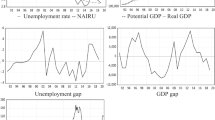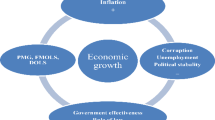Abstract
In this paper, we investigate whether there are asymmetric effects of oil price changes on GDP, industrial production and investment in Turkey for the period between 1998:q1 and 2019:q2 applying the methodology advanced by Kilian and Vigfusson (Quant Econ 2(3):419–453, 2011a). Based on the results of the slope-based tests, we cannot find significant evidence against the null of symmetry in the effects of oil price shocks on real GDP growth, industrial production growth and investment. Next, we concentrate on the impulse response-based tests which allow us to examine the issue of asymmetry of the impulse response functions directly. Overall, both the results of the impulse response-based symmetry tests and the impulse response analysis present significant evidence confirming the asymmetry in the responses to real oil price shocks. That is, our findings show that the responses of all macroeconomic aggregates to positive oil price shocks are considerably greater than those of to negative oil price shocks, especially at short horizons. Moreover, the asymmetry seems to be more apparent in the responses of investment and industrial production growth. Our study also emphasizes the importance of using an appropriate model to analyze the underlying relations.


Similar content being viewed by others
Notes
References
Alsalman Z, Herrera AM (2015) Oil price shocks and the US stock market: do sign and size matter? Energy J, 171–188
Alsalman ZN, Karaki MB (2019) Oil prices and personal consumption expenditures: does the source of the shock matter? Oxford Bull Econ Stat 81(2):250–270
Bernanke BS (1983) Irreversibility, uncertainty, and cyclical investment. Q J Econ 98(1):85–106
Bernanke BS, Gertler M, Watson M, Sims CA, Friedman BM (1997) Systematic monetary policy and the effects of oil price shocks. Brook Pap Econ Act 1997(1):91–157
Brown SP, Yücel MK (1999) Oil prices and US aggregate economic activity: a question of neutrality. In: Economic and financial review-federal reserve bank of Dallas, pp 16–23
Brown SP, Yücel MK (2002) Energy prices and aggregate economic activity: an interpretative survey. Q Rev Econ Finance 42(2):193–208
Çatık AN, Önder AÖ (2013) An asymmetric analysis of the relationship between oil prices and output: the case of Turkey. Econ Model 33:884–892
Davis SJ (1987a) Allocative disturbances and specific capital in real business cycle theories. Am Econ Rev 77(2):326–332
Davis SJ (1987b) Fluctuations in the pace of labor reallocation. In: Carnegie-Rochester conference series on public policy, vol. 27, pp 335–402. North-Holland
Davis SJ, Haltiwanger J (2001) Sectoral job creation and destruction responses to oil price changes. J Monet Econ 48(3):465–512
Elder J, Serletis A (2010) Oil price uncertainty. J Money Credit Bank 42(6):1137–1159
Hamilton JD (1983) Oil and the macroeconomy since World War II. J Polit Econ 91(2):228–248
Hamilton JD (1988) A neoclassical model of unemployment and the business cycle. J Polit Econ 96(3):593–617
Hamilton JD (1996) This is what happened to the oil price-macroeconomy relationship. J Monet Econ 38(2):215–220
Hamilton JD (2003) What is an oil shock? J Econom 113(2):363–398
Hamilton JD (2011) Nonlinearities and the macroeconomic effects of oil prices. Macroecon Dyn 15(S3):364–378
Herrera AM, Karaki MB (2015) The effects of oil price shocks on job reallocation. J Econ Dyn Control 61:95–113
Herrera AM, Karaki MB, Rangaraju SK (2017) Where do jobs go when oil prices drop? Energy Econ 64:469–482
Herrera AM, Karaki MB, Rangaraju SK (2019) Oil price shocks and US economic activity. Energy Policy 129:89–99
Herrera AM, Lagalo LG, Wada T (2011) Oil price shocks and industrial production: is the relationship linear? Macroecon Dyn 15(S3):472–497
Herrera AM, Lagalo LG, Wada T (2015) Asymmetries in the response of economic activity to oil price increases and decreases? J Int Money Finance 50:108–133
Hooker MA (1996) What happened to the oil price-macroeconomy relationship? J Monet Econ 38(2):195–213
Huntington HG (1998) Crude oil prices and US economic performance: where does the asymmetry reside? Energy J 19(4)
Karaki MB (2017) Nonlinearities in the response of real GDP to oil price shocks. Econ Lett 161:146–148
Karaki MB (2018a) Asymmetries in the responses of regional job flows to oil price shocks. Econ Inq 56(3):1827–1845
Karaki MB (2018b) Oil prices and state unemployment rates. Energy J 39(3):25–49
Kilian L (2008) The economic effects of energy price shocks. J Econ Lit 46(4):871–909
Kilian L, Vigfusson RJ (2011a) Are the responses of the US economy asymmetric in energy price increases and decreases? Quant Econ 2(3):419–453
Kilian L, Vigfusson RJ (2011b) Nonlinearities in the oil price-output relationship. Macroecon Dyn 15(S3):337–363
Kilian L, Vigfusson RJ (2013) Do oil prices help forecast us real GDP? the role of nonlinearities and asymmetries. J Bus Econ Stat 31(1):78–93
Kilian L, Vigfusson RJ (2017) The role of oil price shocks in causing US recessions. J Money Credit Bank 49(8):1747–1776
Koop G, Pesaran MH, Potter SM (1996) Impulse response analysis in nonlinear multivariate models. J Econom 74(1):119–147
Lee K, Ni S, Ratti RA (1995) Oil shocks and the macroeconomy: the role of price variability. Energy J 16(4):39–56
Maghyereh AI, Awartani B, Sweidan OD (2019) Oil price uncertainty and real output growth: new evidence from selected oil-importing countries in the Middle East. Empir Econ 56(5):1601–1621
Mork KA (1989) Oil and the macroeconomy when prices go up and down: an extension of Hamilton’s results. J Polit Econ 97(3):740–744
Mory JF (1993) Oil prices and economic activity: is the relationship symmetric? Energy J 14(4):151–161
Pindyck RS (1991) Irreversibility, uncertainty, and investment. J Econ Lit 29(3):1110
Torul O, Alper CE (2010) Asymmetric effects of oil prices on the manufacturing sector in Turkey. Rev Middle East Econ Finance 6(1):90–105
Yalcin Y, Arikan C, Emirmahmutoglu F (2015) Determining the asymmetric effects of oil price changes on macroeconomic variables: a case study of Turkey. Empirica 42(4):737–746
Acknowledgements
The author is thankful to two anonymous referees for their helpful comments and suggestions.
Author information
Authors and Affiliations
Corresponding author
Ethics declarations
Funding:
This study was not funded.
Conflict of interest:
The author declares that she has no conflict of interest.
Ethical approval:
This article does not contain any studies with human participants or animals performed by any of the authors.
Additional information
Publisher's Note
Springer Nature remains neutral with regard to jurisdictional claims in published maps and institutional affiliations.
Rights and permissions
About this article
Cite this article
Kandemir Kocaaslan, O. Are the responses of output and investment to oil price shocks asymmetric?: The case of an oil-importing small open economy. Empir Econ 61, 2501–2516 (2021). https://doi.org/10.1007/s00181-020-01983-4
Received:
Accepted:
Published:
Issue Date:
DOI: https://doi.org/10.1007/s00181-020-01983-4




